Abstract
This review describes the importance of microbial adhesion in the ecology of the urogenital and intestinal tracts and the influence of host and microbial factors in bacterial interference. In a recent revival of interest in bacterial interference, lactobacillus administration has been studied as a means of treating and preventing disease. Although evidence is conflicting, Lactobacillus acidophilus appears to be involved in beneficial antagonistic and cooperative reactions that interfere with establishment of pathogens in the gastrointestinal tract. The mechanisms of action are believed to involve competitive exclusion and production of inhibitory substances, including bacteriocins. These characteristics, as well as demonstrated adherence abilities in vitro, led to selection of certain Lactobacillus strains for clinical studies of cystitis. Weekly intravaginal Lactobacillus therapy reduced the recurrence rate of uncomplicated lower urinary tract infections in women. Use of Lactobacillus strains resistant to Nonoxynol-9, a spermicide that kills members of the protective normal vaginal flora, may have potential for use in women with recurrent cystitis using this contraceptive agent. In veterinary studies, bacterial interference by administration of probiotics has also been beneficial in disease prevention in animals. Carefully selected bacterial mixtures integrate with the gastrointestinal flora of the animals and can confer disease resistance and improve physiological function. Additional human and animal trials are needed to determine the practical, long-term usefulness of bacterial interference as a protective mechanism against infectious diseases.
Full text
PDF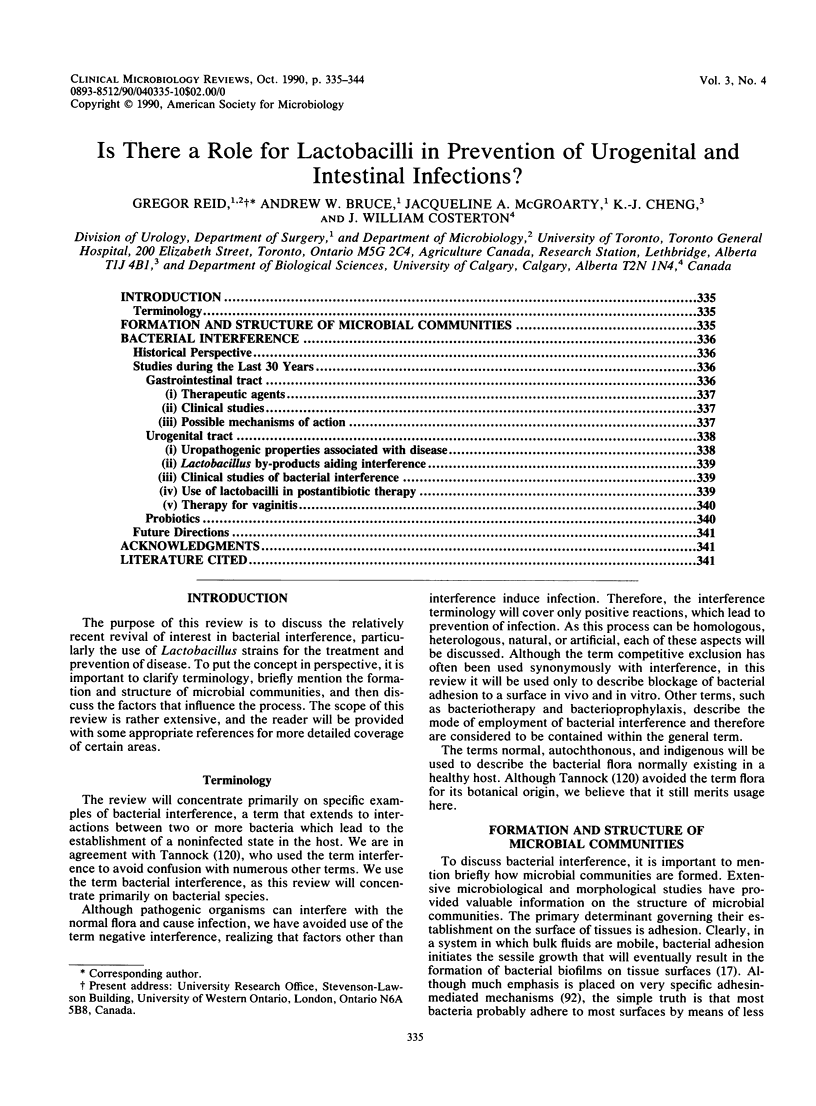
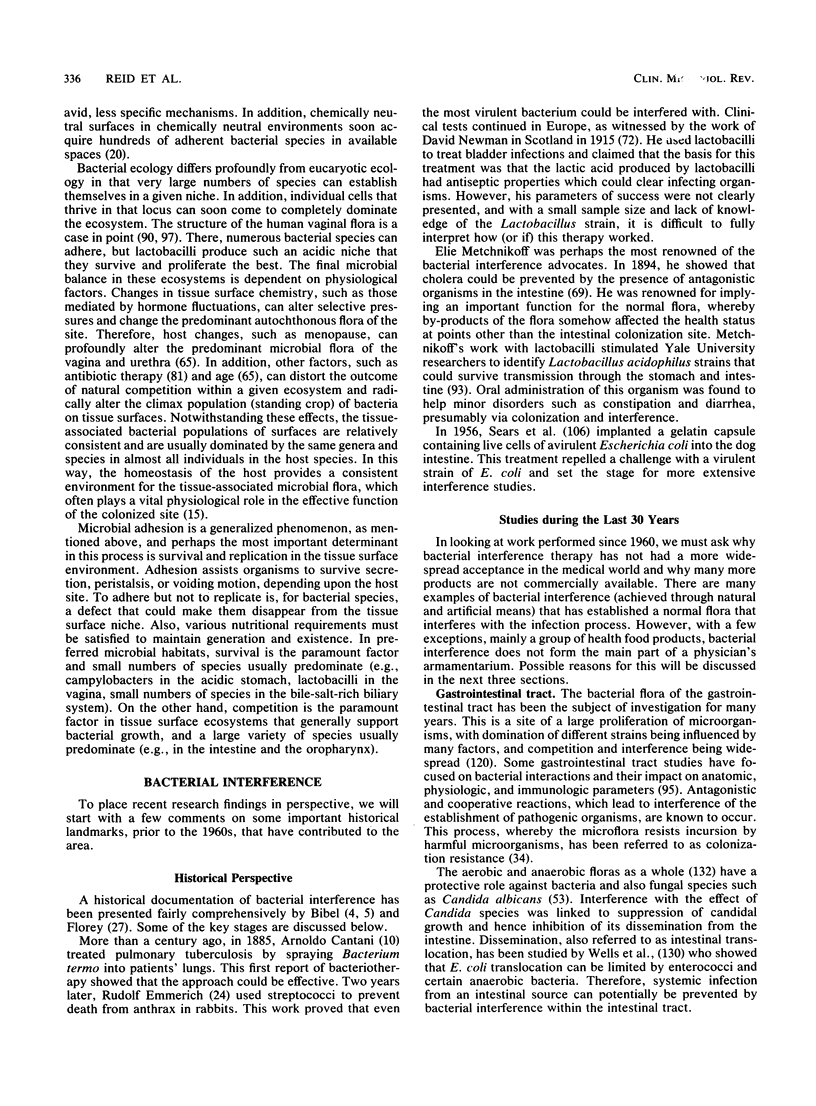
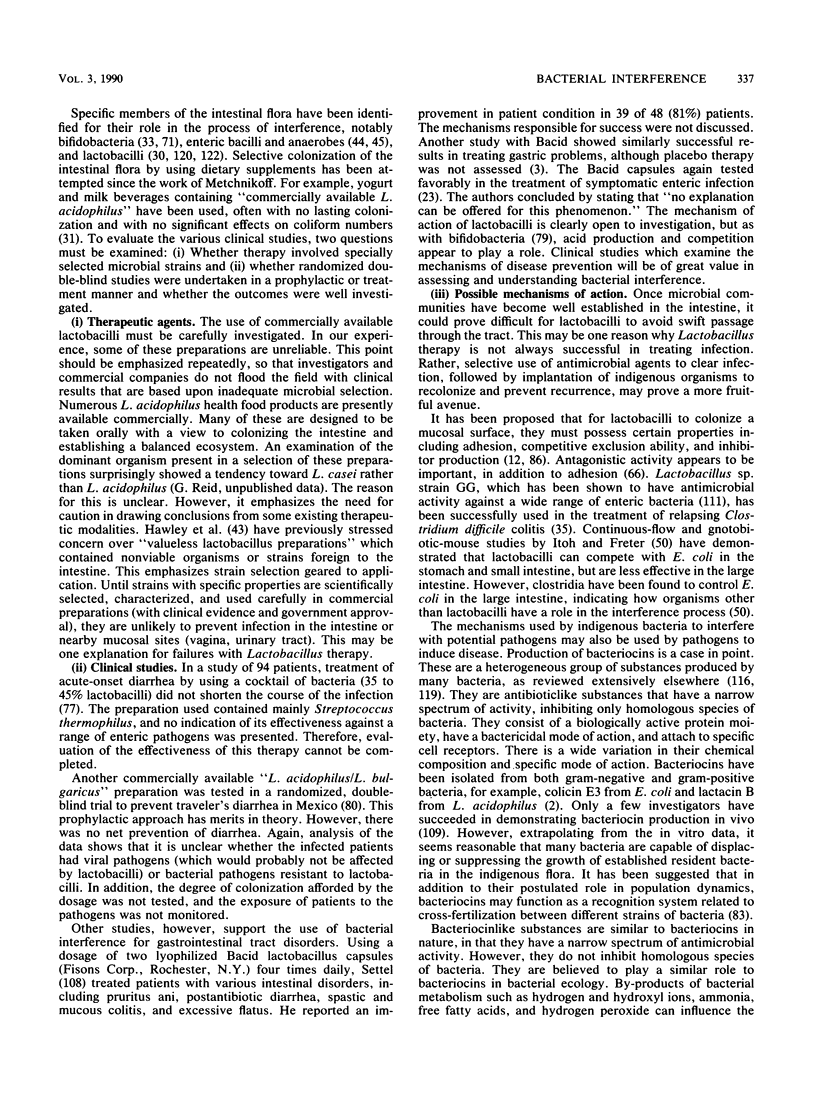
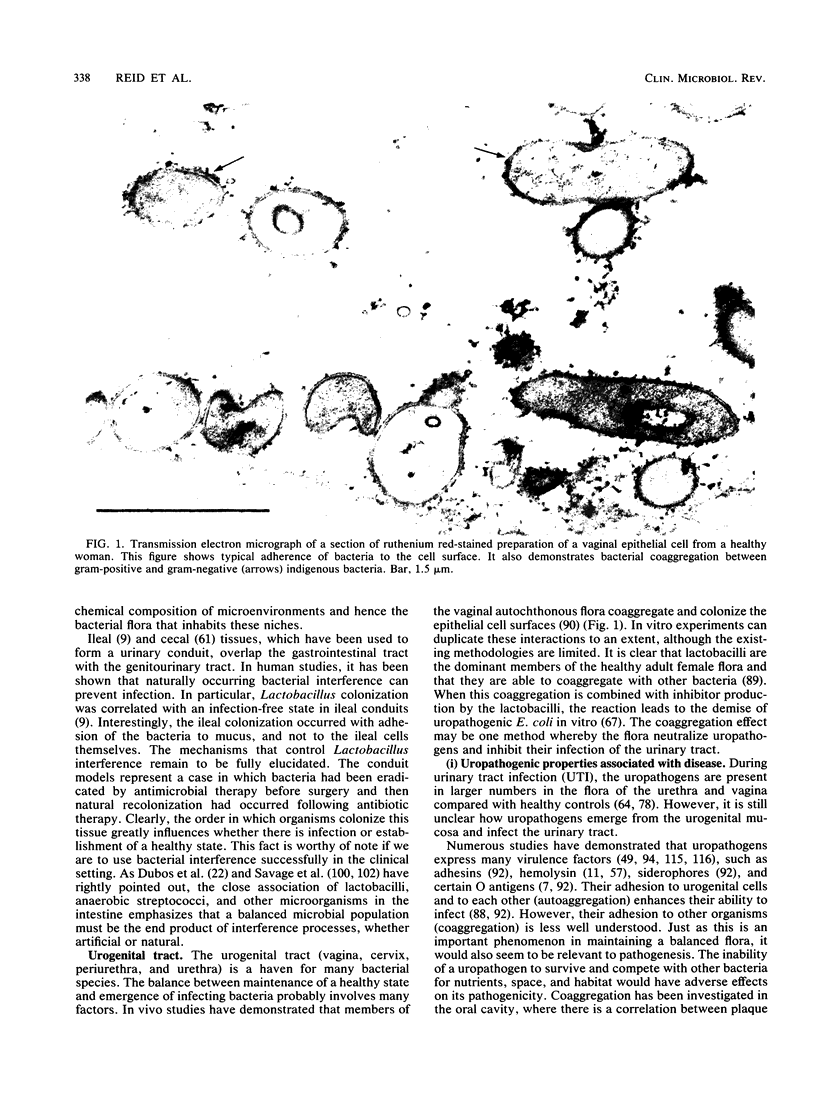
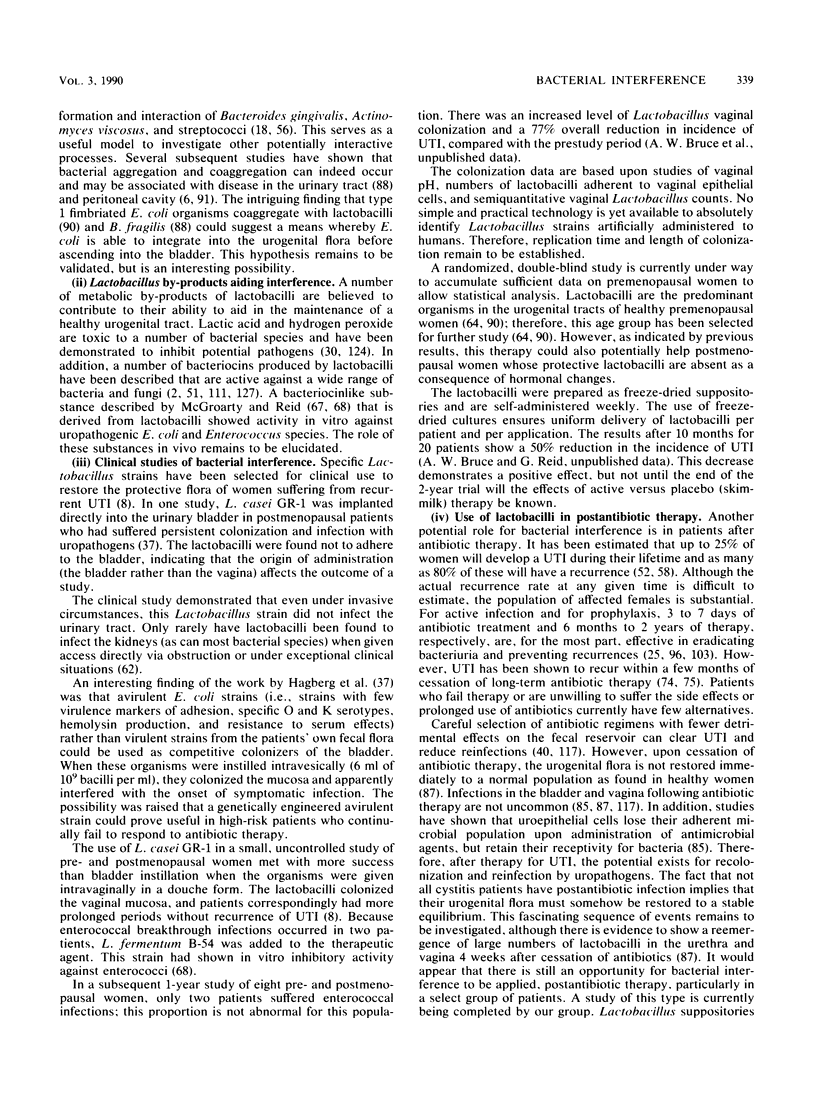
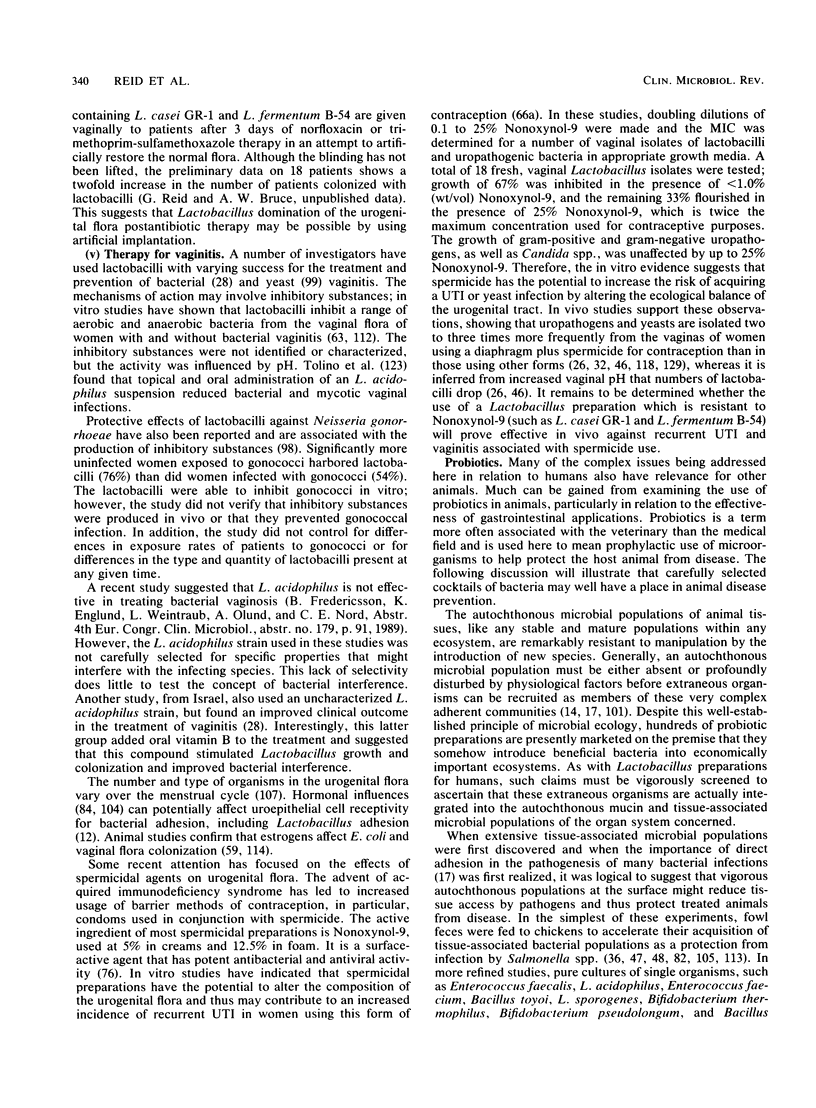
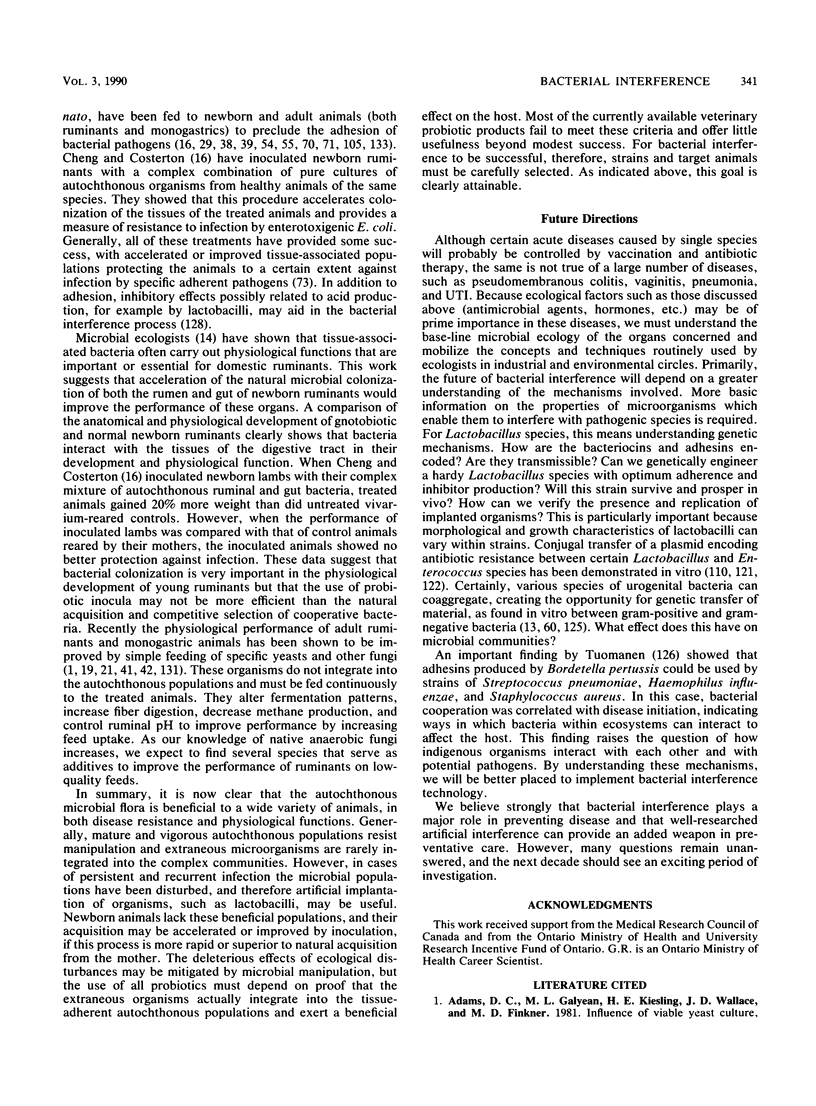
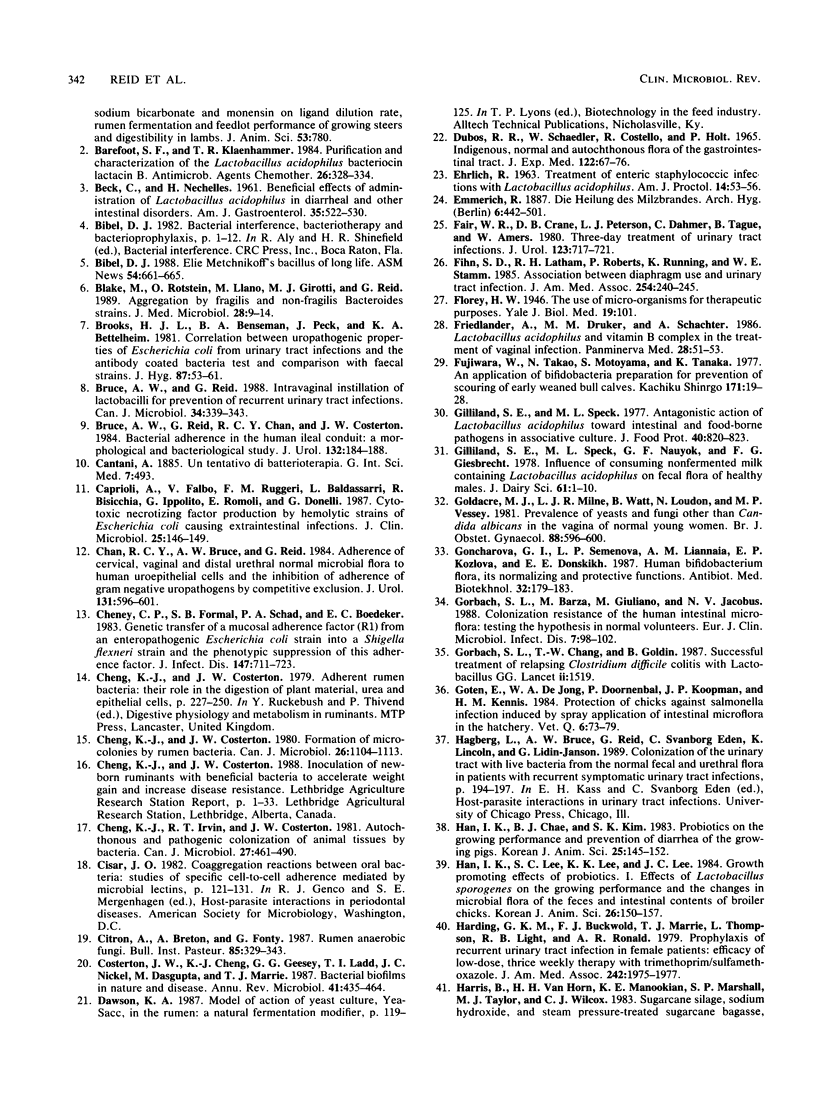
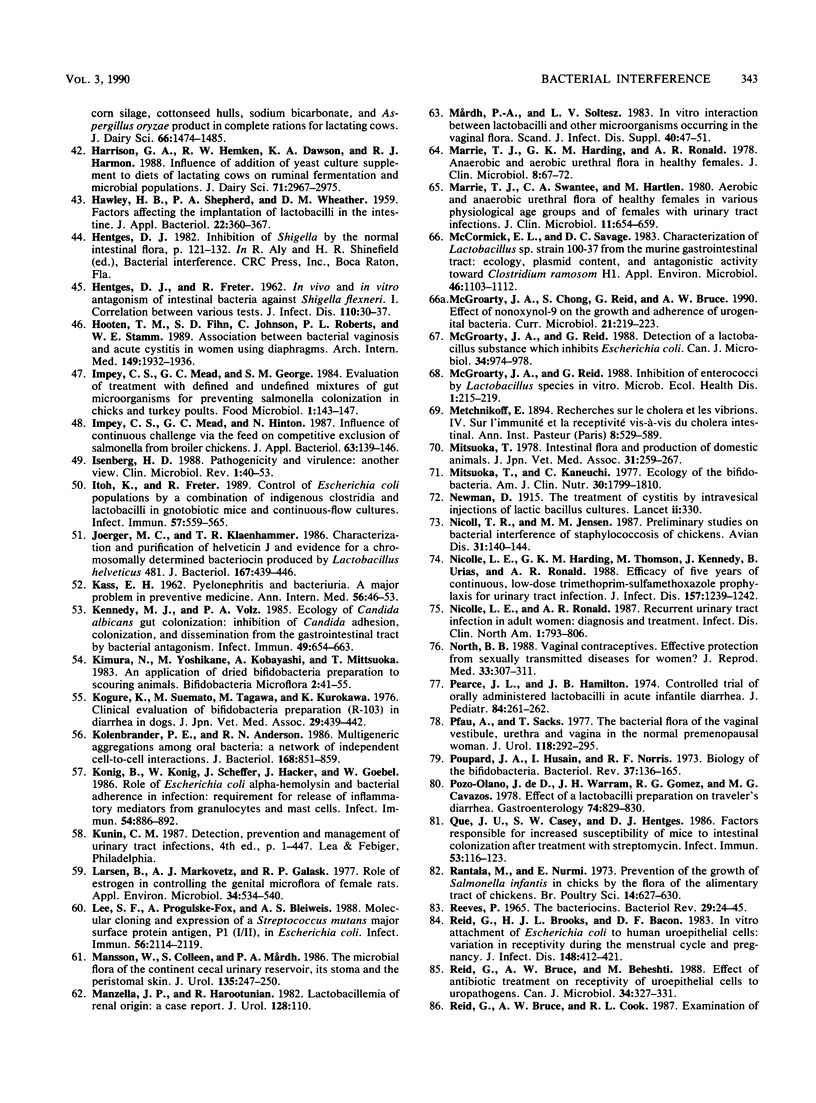
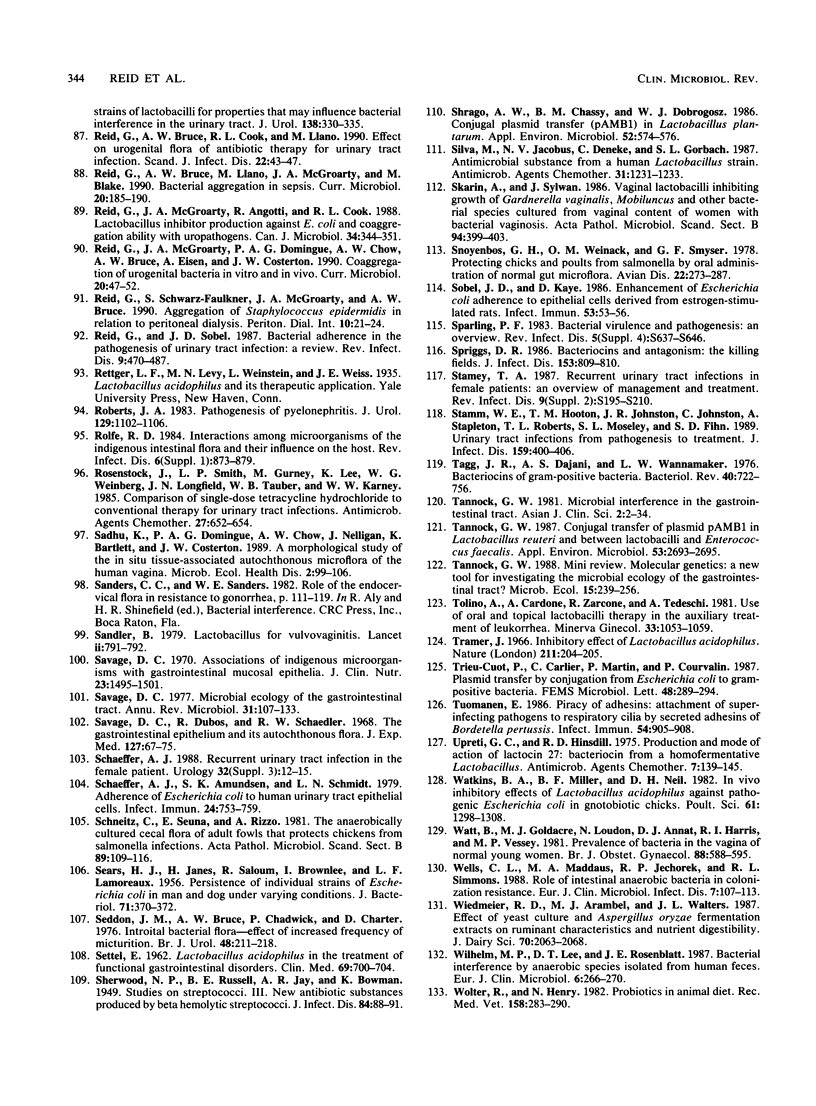
Images in this article
Selected References
These references are in PubMed. This may not be the complete list of references from this article.
- BECK C., NECHELES H. Beneficial effects of administration of Lactobacillus acidophilus in diarrheal and other intestinal disorders. Am J Gastroenterol. 1961 May;35:522–530. [PubMed] [Google Scholar]
- Barefoot S. F., Klaenhammer T. R. Purification and characterization of the Lactobacillus acidophilus bacteriocin lactacin B. Antimicrob Agents Chemother. 1984 Sep;26(3):328–334. doi: 10.1128/aac.26.3.328. [DOI] [PMC free article] [PubMed] [Google Scholar]
- Blake M., Rotstein O. D., Llano M., Girotti M. J., Reid G. Aggregation by fragilis and non-fragilis Bacteroides strains in vitro. J Med Microbiol. 1989 Jan;28(1):9–14. doi: 10.1099/00222615-28-1-9. [DOI] [PubMed] [Google Scholar]
- Brooks H. J., Benseman B. A., Peck J., Bettelheim K. A. Correlation between uropathogenic properties of Escherichia coli from urinary tract infections and the antibody-coated bacteria test and comparison with faecal strains. J Hyg (Lond) 1981 Aug;87(1):53–61. doi: 10.1017/s0022172400069230. [DOI] [PMC free article] [PubMed] [Google Scholar]
- Bruce A. W., Reid G., Chan R. C., Costerton J. W. Bacterial adherence in the human ileal conduit: a morphological and bacteriological study. J Urol. 1984 Jul;132(1):184–188. doi: 10.1016/s0022-5347(17)49516-4. [DOI] [PubMed] [Google Scholar]
- Bruce A. W., Reid G. Intravaginal instillation of lactobacilli for prevention of recurrent urinary tract infections. Can J Microbiol. 1988 Mar;34(3):339–343. doi: 10.1139/m88-062. [DOI] [PubMed] [Google Scholar]
- Caprioli A., Falbo V., Ruggeri F. M., Baldassarri L., Bisicchia R., Ippolito G., Romoli E., Donelli G. Cytotoxic necrotizing factor production by hemolytic strains of Escherichia coli causing extraintestinal infections. J Clin Microbiol. 1987 Jan;25(1):146–149. doi: 10.1128/jcm.25.1.146-149.1987. [DOI] [PMC free article] [PubMed] [Google Scholar]
- Chan R. C., Bruce A. W., Reid G. Adherence of cervical, vaginal and distal urethral normal microbial flora to human uroepithelial cells and the inhibition of adherence of gram-negative uropathogens by competitive exclusion. J Urol. 1984 Mar;131(3):596–601. doi: 10.1016/s0022-5347(17)50512-1. [DOI] [PubMed] [Google Scholar]
- Cheney C. P., Formal S. B., Schad P. A., Boedeker E. C. Genetic transfer of a mucosal adherence factor (R1) from an enteropathogenic Escherichia coli strain into a Shigella flexneri strain and the phenotypic suppression of this adherence factor. J Infect Dis. 1983 Apr;147(4):711–723. doi: 10.1093/infdis/147.4.711. [DOI] [PubMed] [Google Scholar]
- Cheng K. J., Costerton J. W. The formation of microcolonies by rumen bacteria. Can J Microbiol. 1980 Sep;26(9):1104–1113. doi: 10.1139/m80-183. [DOI] [PubMed] [Google Scholar]
- Cheng K. J., Irvin R. T., Costerton J. W. Autochthonous and pathogenic colonization of animal tissues by bacteria. Can J Microbiol. 1981 May;27(5):461–490. doi: 10.1139/m81-071. [DOI] [PubMed] [Google Scholar]
- Costerton J. W., Cheng K. J., Geesey G. G., Ladd T. I., Nickel J. C., Dasgupta M., Marrie T. J. Bacterial biofilms in nature and disease. Annu Rev Microbiol. 1987;41:435–464. doi: 10.1146/annurev.mi.41.100187.002251. [DOI] [PubMed] [Google Scholar]
- DUBOS R., SCHAEDLER R. W., COSTELLO R., HOET P. INDIGENOUS, NORMAL, AND AUTOCHTHONOUS FLORA OF THE GASTROINTESTINAL TRACT. J Exp Med. 1965 Jul 1;122:67–76. doi: 10.1084/jem.122.1.67. [DOI] [PMC free article] [PubMed] [Google Scholar]
- Fair W. R., Crane D. B., Peterson L. J., Dahmer C., Tague B., Amos W. Three-day treatment of urinary tract infections. J Urol. 1980 May;123(5):717–721. doi: 10.1016/s0022-5347(17)56104-2. [DOI] [PubMed] [Google Scholar]
- Fihn S. D., Latham R. H., Roberts P., Running K., Stamm W. E. Association between diaphragm use and urinary tract infection. JAMA. 1985 Jul 12;254(2):240–245. [PubMed] [Google Scholar]
- Friedlander A., Druker M. M., Schachter A. Lactobacillus acidophillus and vitamin B complex in the treatment of vaginal infection. Panminerva Med. 1986 Jan-Mar;28(1):51–53. [PubMed] [Google Scholar]
- Goldacre M. J., Milne L. J., Watt B., Loudon N., Vessey M. P. Prevalence of Yeast and fungi other than Candida albicans in the vagina of normal young women. Br J Obstet Gynaecol. 1981 Jun;88(6):596–600. doi: 10.1111/j.1471-0528.1981.tb01214.x. [DOI] [PubMed] [Google Scholar]
- Goncharova G. I., Semenova L. P., Liannaia A. M., Kozlova E. P., Donskikh E. E. Bifidoflora cheloveka, ee normalizuiushchie i zashchitnye funktsii. Antibiot Med Biotekhnol. 1987 Mar;32(3):179–183. [PubMed] [Google Scholar]
- Gorbach S. L., Barza M., Giuliano M., Jacobus N. V. Colonization resistance of the human intestinal microflora: testing the hypothesis in normal volunteers. Eur J Clin Microbiol Infect Dis. 1988 Feb;7(1):98–102. doi: 10.1007/BF01962192. [DOI] [PubMed] [Google Scholar]
- Gorbach S. L., Chang T. W., Goldin B. Successful treatment of relapsing Clostridium difficile colitis with Lactobacillus GG. Lancet. 1987 Dec 26;2(8574):1519–1519. doi: 10.1016/s0140-6736(87)92646-8. [DOI] [PubMed] [Google Scholar]
- Goren E., de Jong W. A., Doornenbal P., Koopman J. P., Kennis H. M. Protection of chicks against salmonella infection induced by spray application of intestinal microflora in the hatchery. Vet Q. 1984 Apr;6(2):73–79. doi: 10.1080/01652176.1984.9693915. [DOI] [PubMed] [Google Scholar]
- HENTGES D. J., FRETER R. In vivo and in vitro antagonism of intestinal bacteria against Shigella flexneri. I. Correlation between various tests. J Infect Dis. 1962 Jan-Feb;110:30–37. doi: 10.1093/infdis/110.1.30. [DOI] [PubMed] [Google Scholar]
- Harding G. K., Buckwold F. J., Marrie T. J., Thompson L., Light R. B., Ronald A. R. Prophylaxis of recurrent urinary tract infection in female patients. Efficacy of low-dose, thrice-weekly therapy with trimethoprim-sulfamethoxazole. JAMA. 1979 Nov 2;242(18):1975–1977. [PubMed] [Google Scholar]
- Harrison G. A., Hemken R. W., Dawson K. A., Harmon R. J., Barker K. B. Influence of addition of yeast culture supplement to diets of lactating cows on ruminal fermentation and microbial populations. J Dairy Sci. 1988 Nov;71(11):2967–2975. doi: 10.3168/jds.S0022-0302(88)79894-X. [DOI] [PubMed] [Google Scholar]
- Hooton T. M., Fihn S. D., Johnson C., Roberts P. L., Stamm W. E. Association between bacterial vaginosis and acute cystitis in women using diaphragms. Arch Intern Med. 1989 Sep;149(9):1932–1936. [PubMed] [Google Scholar]
- Hseuh A. M., Hsu S. C., Chow L. P., Chow B. F. Maternal nutrition: a positive approach in family planning. Ecol Food Nutr. 1973;2(2):99–106. doi: 10.1080/03670244.1973.9990324. [DOI] [PubMed] [Google Scholar]
- Impey C. S., Mead G. C., Hinton M. Influence of continuous challenge via the feed on competitive exclusion of salmonellas from broiler chicks. J Appl Bacteriol. 1987 Aug;63(2):139–146. doi: 10.1111/j.1365-2672.1987.tb02696.x. [DOI] [PubMed] [Google Scholar]
- Isenberg H. D. Pathogenicity and virulence: another view. Clin Microbiol Rev. 1988 Jan;1(1):40–53. doi: 10.1128/cmr.1.1.40. [DOI] [PMC free article] [PubMed] [Google Scholar]
- Itoh K., Freter R. Control of Escherichia coli populations by a combination of indigenous clostridia and lactobacilli in gnotobiotic mice and continuous-flow cultures. Infect Immun. 1989 Feb;57(2):559–565. doi: 10.1128/iai.57.2.559-565.1989. [DOI] [PMC free article] [PubMed] [Google Scholar]
- Joerger M. C., Klaenhammer T. R. Characterization and purification of helveticin J and evidence for a chromosomally determined bacteriocin produced by Lactobacillus helveticus 481. J Bacteriol. 1986 Aug;167(2):439–446. doi: 10.1128/jb.167.2.439-446.1986. [DOI] [PMC free article] [PubMed] [Google Scholar]
- Joint annual meetings of the American Dairy Science Association and American Society of Animal Science, July 9--13, 1978 Michigan State University, East Lansing, Michigan. Abstracts. J Dairy Sci. 1978;61 (Suppl 1):1–238. [PubMed] [Google Scholar]
- KASS E. H. Pyelonephritis and bacteriuria. A major problem in preventive medicine. Ann Intern Med. 1962 Jan;56:46–53. doi: 10.7326/0003-4819-56-1-46. [DOI] [PubMed] [Google Scholar]
- Kennedy M. J., Volz P. A. Ecology of Candida albicans gut colonization: inhibition of Candida adhesion, colonization, and dissemination from the gastrointestinal tract by bacterial antagonism. Infect Immun. 1985 Sep;49(3):654–663. doi: 10.1128/iai.49.3.654-663.1985. [DOI] [PMC free article] [PubMed] [Google Scholar]
- Kolenbrander P. E., Andersen R. N. Multigeneric aggregations among oral bacteria: a network of independent cell-to-cell interactions. J Bacteriol. 1986 Nov;168(2):851–859. doi: 10.1128/jb.168.2.851-859.1986. [DOI] [PMC free article] [PubMed] [Google Scholar]
- König B., König W., Scheffer J., Hacker J., Goebel W. Role of Escherichia coli alpha-hemolysin and bacterial adherence in infection: requirement for release of inflammatory mediators from granulocytes and mast cells. Infect Immun. 1986 Dec;54(3):886–892. doi: 10.1128/iai.54.3.886-892.1986. [DOI] [PMC free article] [PubMed] [Google Scholar]
- Larsen B., Markovetz A. J., Galask R. P. Role of estrogen in controlling the genital microflora of female rats. Appl Environ Microbiol. 1977 Nov;34(5):534–540. doi: 10.1128/aem.34.5.534-540.1977. [DOI] [PMC free article] [PubMed] [Google Scholar]
- Lee S. F., Progulske-Fox A., Bleiweis A. S. Molecular cloning and expression of a Streptococcus mutans major surface protein antigen, P1 (I/II), in Escherichia coli. Infect Immun. 1988 Aug;56(8):2114–2119. doi: 10.1128/iai.56.8.2114-2119.1988. [DOI] [PMC free article] [PubMed] [Google Scholar]
- Manzella J. P., Harootunian R. Lactobacillemia of renal origin: a case report. J Urol. 1982 Jul;128(1):110–110. doi: 10.1016/s0022-5347(17)52776-7. [DOI] [PubMed] [Google Scholar]
- Marrie T. J., Harding G. K., Ronald A. R. Anaerobic and aerobic urethral flora in healthy females. J Clin Microbiol. 1978 Jul;8(1):67–72. doi: 10.1128/jcm.8.1.67-72.1978. [DOI] [PMC free article] [PubMed] [Google Scholar]
- Marrie T. J., Swantee C. A., Hartlen M. Aerobic and anaerobic urethral flora of healthy females in various physiological age groups and of females with urinary tract infections. J Clin Microbiol. 1980 Jun;11(6):654–659. doi: 10.1128/jcm.11.6.654-659.1980. [DOI] [PMC free article] [PubMed] [Google Scholar]
- McCormick E. L., Savage D. C. Characterization of Lactobacillus sp. strain 100-37 from the murine gastrointestinal tract: ecology, plasmid content, and antagonistic activity toward Clostridium ramosum H1. Appl Environ Microbiol. 1983 Nov;46(5):1103–1112. doi: 10.1128/aem.46.5.1103-1112.1983. [DOI] [PMC free article] [PubMed] [Google Scholar]
- McGroarty J. A., Reid G. Detection of a Lactobacillus substance that inhibits Escherichia coli. Can J Microbiol. 1988 Aug;34(8):974–978. doi: 10.1139/m88-171. [DOI] [PubMed] [Google Scholar]
- Mitsuoka T., Kaneuchi C. Ecology of the bifidobacteria. Am J Clin Nutr. 1977 Nov;30(11):1799–1810. doi: 10.1093/ajcn/30.11.1799. [DOI] [PubMed] [Google Scholar]
- Månsson W., Colleen S., Mårdh P. A. The microbial flora of the continent cecal urinary reservoir, its stoma and the peristomal skin. J Urol. 1986 Feb;135(2):247–250. doi: 10.1016/s0022-5347(17)45599-6. [DOI] [PubMed] [Google Scholar]
- Mårdh P. A., Soltész L. V. In vitro interactions between lactobacilli and other microorganisms occurring in the vaginal flora. Scand J Infect Dis Suppl. 1983;40:47–51. [PubMed] [Google Scholar]
- Nicoll T. R., Jensen M. M. Preliminary studies on bacterial interference of staphylococcosis of chickens. Avian Dis. 1987 Jan-Mar;31(1):140–144. [PubMed] [Google Scholar]
- Nicolle L. E., Harding G. K., Thomson M., Kennedy J., Urias B., Ronald A. R. Efficacy of five years of continuous, low-dose trimethoprim-sulfamethoxazole prophylaxis for urinary tract infection. J Infect Dis. 1988 Jun;157(6):1239–1242. doi: 10.1093/infdis/157.6.1239. [DOI] [PubMed] [Google Scholar]
- Nicolle L. E., Ronald A. R. Recurrent urinary tract infection in adult women: diagnosis and treatment. Infect Dis Clin North Am. 1987 Dec;1(4):793–806. [PubMed] [Google Scholar]
- North B. B. Vaginal contraceptives. Effective protection from sexually transmitted diseases for women? J Reprod Med. 1988 Mar;33(3):307–311. [PubMed] [Google Scholar]
- Pearce J. L., Hamilton J. R. Controlled trial of orally administered lactobacilli in acute infantile diarrhea. J Pediatr. 1974 Feb;84(2):261–262. doi: 10.1016/s0022-3476(74)80618-9. [DOI] [PubMed] [Google Scholar]
- Pfau A., Sacks T. The bacterial flora of the vaginal vestibule, urethra and vagina in the normal premenopausal woman. J Urol. 1977 Aug;118(2):292–295. doi: 10.1016/s0022-5347(17)57976-8. [DOI] [PubMed] [Google Scholar]
- Poupard J. A., Husain I., Norris R. F. Biology of the bifidobacteria. Bacteriol Rev. 1973 Jun;37(2):136–165. doi: 10.1128/br.37.2.136-165.1973. [DOI] [PMC free article] [PubMed] [Google Scholar]
- Que J. U., Casey S. W., Hentges D. J. Factors responsible for increased susceptibility of mice to intestinal colonization after treatment with streptomycin. Infect Immun. 1986 Jul;53(1):116–123. doi: 10.1128/iai.53.1.116-123.1986. [DOI] [PMC free article] [PubMed] [Google Scholar]
- REEVES P. THE BACTERIOCINS. Bacteriol Rev. 1965 Mar;29:24–45. doi: 10.1128/br.29.1.24-45.1965. [DOI] [PMC free article] [PubMed] [Google Scholar]
- Rantala M., Nurmi E. Prevention of the growth of Salmonella infantis in chicks by the flora of the alimentary tract of chickens. Br Poult Sci. 1973 Nov;14(6):627–630. doi: 10.1080/00071667308416073. [DOI] [PubMed] [Google Scholar]
- Reid G., Brooks H. J., Bacon D. F. In vitro attachment of Escherichia coli to human uroepithelial cells: variation in receptivity during the menstrual cycle and pregnancy. J Infect Dis. 1983 Sep;148(3):412–421. doi: 10.1093/infdis/148.3.412. [DOI] [PubMed] [Google Scholar]
- Reid G., Bruce A. W., Beheshti M. Effect of antibiotic treatment on receptivity of uroepithelial cells to uropathogens. Can J Microbiol. 1988 Mar;34(3):327–331. doi: 10.1139/m88-060. [DOI] [PubMed] [Google Scholar]
- Reid G., Bruce A. W., Cook R. L., Llano M. Effect on urogenital flora of antibiotic therapy for urinary tract infection. Scand J Infect Dis. 1990;22(1):43–47. doi: 10.3109/00365549009023118. [DOI] [PubMed] [Google Scholar]
- Reid G., McGroarty J. A., Angotti R., Cook R. L. Lactobacillus inhibitor production against Escherichia coli and coaggregation ability with uropathogens. Can J Microbiol. 1988 Mar;34(3):344–351. doi: 10.1139/m88-063. [DOI] [PubMed] [Google Scholar]
- Reid G., Schwarz-Faulkner S., McGroarty J. A., Bruce A. W. Bacterial aggregation in relation to peritoneal dialysis. Perit Dial Int. 1990;10(1):21–24. [PubMed] [Google Scholar]
- Reid G., Sobel J. D. Bacterial adherence in the pathogenesis of urinary tract infection: a review. Rev Infect Dis. 1987 May-Jun;9(3):470–487. doi: 10.1093/clinids/9.3.470. [DOI] [PubMed] [Google Scholar]
- Roberts J. A. Pathogenesis of pyelonephritis. J Urol. 1983 Jun;129(6):1102–1106. doi: 10.1016/s0022-5347(17)52592-6. [DOI] [PubMed] [Google Scholar]
- Rosenstock J., Smith L. P., Gurney M., Lee K., Weinberg W. G., Longfield J. N., Tauber W. B., Karney W. W. Comparison of single-dose tetracycline hydrochloride to conventional therapy of urinary tract infections. Antimicrob Agents Chemother. 1985 Apr;27(4):652–654. doi: 10.1128/aac.27.4.652. [DOI] [PMC free article] [PubMed] [Google Scholar]
- SEARS H. J., JANES H., SALOUM R., BROWNLEE I., LAMOREAUX L. F. Persistence of individual strains of Escherichia coli in man and dog under varying conditions. J Bacteriol. 1956 Mar;71(3):370–372. doi: 10.1128/jb.71.3.370-372.1956. [DOI] [PMC free article] [PubMed] [Google Scholar]
- Sandler B. Lactobacillus for vulvovaginitis. Lancet. 1979 Oct 13;2(8146):791–792. doi: 10.1016/s0140-6736(79)92135-4. [DOI] [PubMed] [Google Scholar]
- Savage D. C. Associations of indigenous microorganisms with gastrointestinal mucosal epithelia. Am J Clin Nutr. 1970 Nov;23(11):1495–1501. doi: 10.1093/ajcn/23.11.1495. [DOI] [PubMed] [Google Scholar]
- Savage D. C., Dubos R., Schaedler R. W. The gastrointestinal epithelium and its autochthonous bacterial flora. J Exp Med. 1968 Jan 1;127(1):67–76. doi: 10.1084/jem.127.1.67. [DOI] [PMC free article] [PubMed] [Google Scholar]
- Savage D. C. Microbial ecology of the gastrointestinal tract. Annu Rev Microbiol. 1977;31:107–133. doi: 10.1146/annurev.mi.31.100177.000543. [DOI] [PubMed] [Google Scholar]
- Schaeffer A. J., Amundsen S. K., Schmidt L. N. Adherence of Escherichia coli to human urinary tract epithelial cells. Infect Immun. 1979 Jun;24(3):753–759. doi: 10.1128/iai.24.3.753-759.1979. [DOI] [PMC free article] [PubMed] [Google Scholar]
- Schaeffer A. J. Recurrent urinary tract infection in the female patient. Urology. 1988 Sep;32(3 Suppl):12–15. [PubMed] [Google Scholar]
- Schneitz C., Seuna E., Rizzo A. The anaerobically cultured cecal flora of adult fowls that protects chickens from Salmonella infections. Acta Pathol Microbiol Scand B. 1981 Apr;89(2):109–116. doi: 10.1111/j.1699-0463.1981.tb00161_89b.x. [DOI] [PubMed] [Google Scholar]
- Seddon J. M., Bruce A. W., Chadwick P., Carter D. Introital bacterial flora - effect of increased frequency of micturition. Br J Urol. 1976 Jun;48(3):211–218. doi: 10.1111/j.1464-410x.1976.tb10203.x. [DOI] [PubMed] [Google Scholar]
- Shrago A. W., Chassy B. M., Dobrogosz W. J. Conjugal plasmid transfer (pAM beta 1) in Lactobacillus plantarum. Appl Environ Microbiol. 1986 Sep;52(3):574–576. doi: 10.1128/aem.52.3.574-576.1986. [DOI] [PMC free article] [PubMed] [Google Scholar]
- Silva M., Jacobus N. V., Deneke C., Gorbach S. L. Antimicrobial substance from a human Lactobacillus strain. Antimicrob Agents Chemother. 1987 Aug;31(8):1231–1233. doi: 10.1128/aac.31.8.1231. [DOI] [PMC free article] [PubMed] [Google Scholar]
- Skarin A., Sylwan J. Vaginal lactobacilli inhibiting growth of Gardnerella vaginalis, Mobiluncus and other bacterial species cultured from vaginal content of women with bacterial vaginosis. Acta Pathol Microbiol Immunol Scand B. 1986 Dec;94(6):399–403. doi: 10.1111/j.1699-0463.1986.tb03074.x. [DOI] [PubMed] [Google Scholar]
- Snoeyenbos G. H., Weinack O. M., Smyser C. F. Protecting chicks and poults from Salmonellae by oral administration of "normal" gut microflora. Avian Dis. 1978 Apr-Jun;22(2):273–287. [PubMed] [Google Scholar]
- Sobel J. D., Kaye D. Enhancement of Escherichia coli adherence to epithelial cells derived from estrogen-stimulated rats. Infect Immun. 1986 Jul;53(1):53–56. doi: 10.1128/iai.53.1.53-56.1986. [DOI] [PMC free article] [PubMed] [Google Scholar]
- Sparling P. F. Bacterial virulence and pathogenesis: an overview. Rev Infect Dis. 1983 Sep-Oct;5 (Suppl 4):S637–S646. doi: 10.1093/clinids/5.supplement_4.s637. [DOI] [PubMed] [Google Scholar]
- Spriggs D. R. Bacteriocins and antagonism: the killing fields. J Infect Dis. 1986 Apr;153(4):809–810. [PubMed] [Google Scholar]
- Stamey T. A. Recurrent urinary tract infections in female patients: an overview of management and treatment. Rev Infect Dis. 1987 Mar-Apr;9 (Suppl 2):S195–S210. doi: 10.1093/clinids/9.supplement_2.s195. [DOI] [PubMed] [Google Scholar]
- Stamm W. E., Hooton T. M., Johnson J. R., Johnson C., Stapleton A., Roberts P. L., Moseley S. L., Fihn S. D. Urinary tract infections: from pathogenesis to treatment. J Infect Dis. 1989 Mar;159(3):400–406. doi: 10.1093/infdis/159.3.400. [DOI] [PubMed] [Google Scholar]
- Tagg J. R., Dajani A. S., Wannamaker L. W. Bacteriocins of gram-positive bacteria. Bacteriol Rev. 1976 Sep;40(3):722–756. doi: 10.1128/br.40.3.722-756.1976. [DOI] [PMC free article] [PubMed] [Google Scholar]
- Tannock G. W. Conjugal transfer of plasmid pAM beta 1 in Lactobacillus reuteri and between lactobacilli and Enterococcus faecalis. Appl Environ Microbiol. 1987 Nov;53(11):2693–2695. doi: 10.1128/aem.53.11.2693-2695.1987. [DOI] [PMC free article] [PubMed] [Google Scholar]
- Tolino A., Cardone A., Zarcone R., Tedeschi A. Impiego della lattobacilloterapia per via orale e topica nel trattamento ausiliario delle leucorree. Minerva Ginecol. 1981 Nov;33(11):1053–1059. [PubMed] [Google Scholar]
- Tramer J. Inhibitory effect of Lactobacillus acidophilus. Nature. 1966 Jul 9;211(5045):204–205. doi: 10.1038/211204a0. [DOI] [PubMed] [Google Scholar]
- Tuomanen E. Piracy of adhesins: attachment of superinfecting pathogens to respiratory cilia by secreted adhesins of Bordetella pertussis. Infect Immun. 1986 Dec;54(3):905–908. doi: 10.1128/iai.54.3.905-908.1986. [DOI] [PMC free article] [PubMed] [Google Scholar]
- Upreti G. C., Hinsdill R. D. Production and mode of action of lactocin 27: bacteriocin from a homofermentative Lactobacillus. Antimicrob Agents Chemother. 1975 Feb;7(2):139–145. doi: 10.1128/aac.7.2.139. [DOI] [PMC free article] [PubMed] [Google Scholar]
- Watkins B. A., Miller B. F., Neil D. H. In vivo inhibitory effects of Lactobacillus acidophilus against pathogenic Escherichia coli in gnotobiotic chicks. Poult Sci. 1982 Jul;61(7):1298–1308. doi: 10.3382/ps.0611298. [DOI] [PubMed] [Google Scholar]
- Watt B., Goldacre M. J., Loudon N., Annat D. J., Harris R. I., Vessey M. P. Prevalence of bacteria in the vagina of normal young women. Br J Obstet Gynaecol. 1981 Jun;88(6):588–595. doi: 10.1111/j.1471-0528.1981.tb01213.x. [DOI] [PubMed] [Google Scholar]
- Wells C. L., Maddaus M. A., Jechorek R. P., Simmons R. L. Role of intestinal anaerobic bacteria in colonization resistance. Eur J Clin Microbiol Infect Dis. 1988 Feb;7(1):107–113. doi: 10.1007/BF01962194. [DOI] [PubMed] [Google Scholar]
- Wiedmeier R. D., Arambel M. J., Walters J. L. Effect of yeast culture and Aspergillus oryzae fermentation extract on ruminal characteristics and nutrient digestibility. J Dairy Sci. 1987 Oct;70(10):2063–2068. doi: 10.3168/jds.S0022-0302(87)80254-0. [DOI] [PubMed] [Google Scholar]
- Wilhelm M. P., Lee D. T., Rosenblatt J. E. Bacterial interference by anaerobic species isolated from human feces. Eur J Clin Microbiol. 1987 Jun;6(3):266–270. doi: 10.1007/BF02017610. [DOI] [PubMed] [Google Scholar]
- de dios Pozo-Olano J., Warram J. H., Jr, Gómez R. G., Cavazos M. G. Effect of a lactobacilli preparation on traveler's diarrhea. A randomized, double blind clinical trial. Gastroenterology. 1978 May;74(5 Pt 1):829–830. [PubMed] [Google Scholar]



